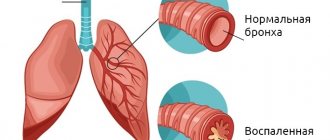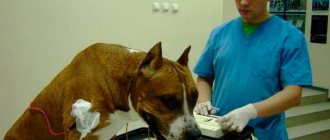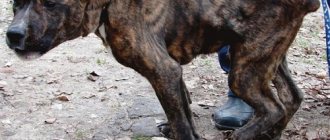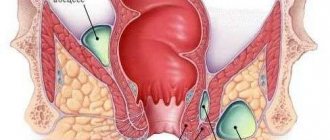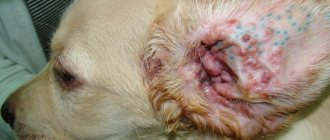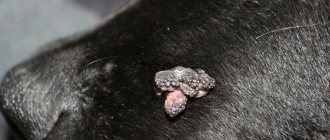Anemia in dogs is one of the most common diagnostic blood test findings. The term "anemia", derived from the Greek words for "blood" and the prefix "negation", literally means a decrease in the amount of blood. Typically, this term refers to a decrease in hematocrit, hemoglobin concentration and red blood cell count below normal limits for a particular species.
A distinction is made between regenerative anemia (with sufficient bone marrow function), which develops after bleeding or hemolysis, and non-regenerative or hypoplastic anemia, with reduced or completely suppressed erythropoiesis, for example, as a result of bone marrow diseases.
Anemia is not a specific disease, but a symptom that occurs in dogs with a variety of pathologies.
Causes of anemia in dogs
What could be the reasons for low red blood cell counts, hemoglobin and hematocrit in dogs? A huge number of pathologies can lead to the development of anemia in dogs; here are the most common of them:
- the presence of bleeding as a result of injury or ulcer in the gastrointestinal tract;
- unbalanced feeding (lack of iron or copper in the diet);
- insufficiency of production of the hormone erythropoietin, which stimulates the formation of red blood cells in the bone marrow (for example, in chronic renal failure, hypothyroidism);
- intoxication (poisoning with heavy metals, food products such as onions and garlic);
- toxic damage to the bone marrow by certain drugs, such as antitumor drugs, phenylbutazone, chloramphenicol, etc.;
- infectious diseases (pyroplasmosis, ehrlichiosis, parvovirus enteritis);
- as well as various other pathological processes in the bone marrow can cause the development of anemia in dogs (myelodysplasia, myelo- and lymphoproliferative diseases, metastases).
Pathogenesis of the disease
Features of pathogenesis depend on several factors:
- From the parasite: virulence of the isolate, whether primary infection or reinfection occurred, infective dose.
- From the owner: Young animals or those with underlying diseases, or those that have not previously had contact with this parasite when entering an endemic area, are more susceptible to the disease, and the course of the disease in such animals is more severe.
The pathogenesis is the same for different Babesia species:
- Mechanical impact: destruction of red blood cells as a result of the proliferation of trophozoites inside these cells. This results in severe anemia (intravascular hemolysis) that persists during parasitemia.
- An increase in vascular permeability leads to the development of edema, vasodilation, arterial hypotension and blood stasis, which leads to metabolic acidosis, which aggravates the course of the disease.
- Red blood cells adhere to the endothelium of blood vessels, causing the risk of thrombosis. The process is aggravated by the formation of immune complexes, which are deposited on the membrane of infected red blood cells and in some tissues.
The development of different clinical outcomes of the disease is possible, depending on the organ affected (liver, kidneys, lungs, skeletal muscles or heart, central nervous system).
Types of anemia
Regenerative anemia
Regenerative anemia usually develops as a result of blood loss or hemolysis (that is, the process of destruction of red blood cells). With blood loss (as a result of injury, ulcer or other pathological processes), the number of red blood cells decreases, but their normal life expectancy is maintained. With hemolytic anemia in dogs, the lifespan of red blood cells decreases - they begin to break down prematurely. Moreover, with hemolytic anemia, the ability of the bone marrow to recover is usually high, because during bleeding, iron is released from the body along with red blood cells, and during hemolysis it enters back into the bloodstream and is used in the synthesis of hemoglobin. The most common example in our country is the development of immune-mediated hemolytic anemia in dogs against the background of piroplasmosis (a disease transmitted through a tick bite).
Non-regenerative anemia
The main symptom of non-regenerative (hypoplastic) anemia is a sharp inhibition of erythropoiesis, that is, new red blood cells stop being produced. In this case, both a violation of only erythropoiesis, when only the number of red blood cells in the blood decreases, and total bone marrow damage, when the number of red blood cells, leukocytes, and platelets in the blood decreases (so-called pancytopenia).
Hypoplastic anemia is a secondary condition, so usually the symptoms of the underlying disease appear earlier than the actual signs of anemia. So, for example, in case of chronic renal failure, first the owners will pay attention to increased thirst, frequent urination, weight loss and odor from the mouth; in the presence of neoplasms, the first sign will be cachexia (extreme exhaustion of the body); in the presence of endocrine pathologies in dogs - bilateral symmetrical loss coat, etc.
With non-regenerative anemia, symptoms often develop gradually, but a sharply worsening course of the underlying disease can cause acute development of anemia (pallor, apathy, rapid heartbeat and breathing). Regenerative anemia is more characterized by the sudden onset of symptoms.
What is immune-mediated hemolytic anemia?
To understand IMHA, you first need to understand the basic role that red blood cells play in a healthy dog's body. Red blood cells carry oxygen to the body's cells and remove carbon dioxide from the bloodstream, both vital functions of a healthy body.
However, anemia occurs when a dog's red blood cell count drops below their normal, healthy level or when their red blood cells do not work properly. This may be caused by blood loss, an underlying disease or health condition, or because the body simply does not produce enough red blood cells in the first place.
In dogs with immune-mediated hemolytic anemia, the condition occurs because the dog's own immune system mistakenly identifies red blood cells as a threat and destroys them when they are released from the bone marrow into the bloodstream.
There are two different types of immunomodulated hemolytic anemia, called primary and secondary, respectively. Primary IMBH occurs when a dog's immune system creates antibodies to destroy red blood cells, and secondary IMBH occurs when an external factor, such as a toxin or health condition, changes the structure and composition of a dog's red blood cells, causing their immune systems to turn on them again.
Looking for free pet advice for your dog?. Click here to join the UKs favorite pet community - PetForums.co.uk
Symptoms of Anemia in Dogs
Symptoms of anemia in dogs depend on the rate of development of blood loss, the body's compensatory capabilities and the severity of the process. In some cases, both with acute and chronic anemia, the owner may not pay attention to changes in the pet’s behavior.
Typically, symptoms of acute blood loss are as follows:
- lethargy;
- pallor of the mucous membranes;
- signs of shock;
- visible signs of bleeding (if there is internal bleeding, there may be black stool - a sign of digested blood).
With chronic blood loss you may notice:
- pallor of the mucous membranes;
- apathy, lethargy of the pet;
- decreased tolerance to physical activity;
- there may be fainting;
- Perverted appetite is common.
But, despite the fact that the symptoms may clearly indicate that the pet has anemia, it is imperative to carry out laboratory diagnostics - at least a general blood test - to identify the type of anemia, its cause and the severity of the disease.
How does pathology manifest itself?
When the level of red blood cells decreases, the dog becomes very lethargic and apathetic. It becomes incredibly difficult for her to endure physical activity. The animal lies all the time and shows no activity.
When the level of red blood cells decreases, the dog becomes lethargic.
There is a sharp decrease in appetite. In the most difficult cases, the dog refuses food. The mucous membranes turn blue or pale. The animal's gums become cold.
But the following signs also appear:
- Fever.
- Unquenchable thirst.
- Polyuria.
- Abnormal stool.
- Vomit.
Diagnostics
To identify anemia and determine its type, as a rule, a general blood test confirmed by a cytological examination of a blood smear is sufficient.
With regenerative anemia, a general blood test shows a decrease in hemoglobin, hematocrit and the number of red blood cells. In some cases, to make a diagnosis, it is enough to only test a drop of blood in dogs for hematocrit - it will be lowered. Sometimes there is a change in the shape and color of red blood cells - anisocytosis and polychromasia. The average volume of erythrocytes is increased or within normal limits, the average concentration of hemoglobin in erythrocytes in dogs is decreased or within normal limits.
With hemolytic anemia, specific external changes in red blood cells are detected - spherocytosis or schizocytosis.
Subscribe to our newsletter and get a free veterinary consultation
Thanks for subscribing!
The main difference between regenerative anemia and non-regenerative anemia is an increase in the number of immature (“young”) forms of red blood cells - reticulocytes (that is, reticulocytosis) and a decrease in hematocrit. But at the early stage of regenerative anemia, the number of reticulocytes (as well as in hypoplastic anemia) may be reduced - in such a situation, a bone marrow puncture may be required to determine the type of anemia. In regenerative anemia, bone marrow hyperplasia is detected, while in hypoplastic anemia it is absent.
If autoimmune hemolytic anemia (aiha in dogs) is suspected, a special direct antiglobulin test is performed - the Coombs test. The presence of antibodies to red blood cells, spherocytosis and polychromasia confirm the diagnosis.
A cytological examination of a blood smear is no less important than a general blood test performed by the analyzer - according to it, a laboratory doctor conducts a complete morphological analysis of the cellular composition of the blood, which helps to establish the type and cause of anemia.
Anemia in puppies
In puppies, anemia can occur as a result of unbalanced feeding, the presence of helminthic infestation or a viral disease such as parvovirus enteritis. Unfortunately, despite widespread vaccination, parvovirus enteritis is a common and difficult to treat disease. But, fortunately, compensatory mechanisms in puppies are well developed, and when the underlying disease is relieved, anemia in puppies quickly goes away.
Treatment of anemia in dogs
Owners often ask doctors the following questions: “What should be done if the dog has low hemoglobin?” or “Does my dog need a blood transfusion?” But, before treating anemia in a dog, you need to find out the reason that caused it.
First of all, specific therapy for the disease is prescribed: for example, if a dog has a blood-parasitic disease, drugs that act on the parasite are used for treatment. If anemia in a dog is caused by chronic kidney disease, it is necessary to take control of the underlying disease and administer a course of the hormone erythropoietin. If anemia is caused by inadequate feeding, then a veterinary nutritionist will answer the question of how to increase hemoglobin in a dog.
It is important to understand that self-prescription of iron, cyanocobalamin and folic acid supplements will most likely not bring any benefit to your pet, and wasted time can negatively affect his health. In general, treatment tactics can differ radically depending on the severity of anemia and the manifestations of symptoms in dogs.
With the slow development of anemia, compensatory mechanisms have time to form in the body, and therefore moderate anemia (hematocrit more than 25%), as a rule, does not require maintenance treatment. With severe anemia (hematocrit below 15-20%), severe oxygen starvation develops, so it is necessary to limit physical activity and blood transfusions.
Severe hypoplastic anemia, which may be associated with oncology and other serious conditions, is often associated with a poor prognosis and requires long-term treatment.
In case of severe anemia, it is necessary to evaluate the hematocrit and blood smear once every 1-2 days; in case of stable condition of the pet and chronic course - every 1-2 weeks.
Acute regenerative anemia requires emergency care. With massive bleeding, shock and intoxication are possible, so it is necessary to take your pet to the clinic as soon as possible, where he will receive help. In the first three days, the pet will be given infusion therapy and, if necessary, a blood transfusion.
Iron supplements are often prescribed orally or intravenously for dogs. However, it is worth noting that it makes sense to use iron supplements in the presence of iron deficiency anemia, which is rare in dogs. This type of anemia develops with prolonged chronic blood loss and inadequate feeding; to confirm the diagnosis, special diagnostics are required (measurement of the level of the hormone ferritin, assessment of iron-binding capacity and other methods).
For hemolytic anemia in dogs, specific treatment is prescribed.
The effectiveness of treatment is assessed by a general blood test, at the initial stage - daily, when the condition stabilizes - every 3-5 days. Usually, with stopped acute blood loss, red blood counts are restored within 14 days.
Diet
The diet for anemia consists of a balanced and proper diet. When feeding dogs with specialized industrial food, anemia will not occur. But if you feed your dog from the table, vegetarian diets, then problems cannot be avoided. Canned baby food, so beloved by many owners, is especially dangerous for dogs - it often contains onions and garlic in quantities allowed for children to enhance the taste, but in dogs they can cause hemolytic anemia. It is also strictly forbidden to add onions and garlic to food: eating onions or garlic in an amount of 5 g/kg of body weight is a toxic dose and can lead to severe anemia.
Predisposing factors
The causes of the pathology are extremely varied. For example, cases of hemolysis developing in animals exposed to high or low temperatures (hyper- and hypothermia) have been described. In addition, exposing the dog to radioactive materials can destroy red blood cells. Of course, this is unlikely to happen “in the wild.” It is much more likely that a sick pet has some dangerous infectious disease. In particular, many pathogenic strains of the most common E. coli can cause blood breakdown.
Some viruses act similarly. In addition, we should not forget about congenital pathologies of the reticuloendothelial system and autoimmune diseases, in which the body itself begins to destroy blood, mistaking it for foreign tissue. In addition, hemolysis develops when incompatible blood is transfused, but this is not typical for our country: since we do not have blood banks for pets, there is nothing to transfuse. Let's look at some predisposing factors in a little more detail.
So, the first possible cause of “decomposition” of blood is bites of poisonous snakes and insects, as well as poisoning with rat poisons, salts of heavy metals, etc. Snake bites are especially dangerous. True, hemolysis occurs only if the venom of a reptile has a hemolytic effect (viper, viper, efa, rattlers, etc.).
Prevention
Since anemia is not an independent disease, prevention consists of eliminating the causes that cause it.
Firstly, this is a balanced diet for pets. If you do not want to feed your dog ready-made food, be sure to seek the help of veterinary nutritionists for help in creating individual diets. For example, nutritionists in the Petstory mobile application will help you create such a diet. You can download it from the link.
Secondly, vaccination. Only timely vaccination according to schedules approved by veterinary specialists can protect pets from infection with severe viral diseases, which can lead to anemia and even death.
Thirdly, we must not forget about mandatory regular treatment against parasites - both internal (helminths) and external (fleas and ticks).
Fourthly, regular medical examination of pets is no less important to identify signs of the disease at an early stage. For older pets, it is recommended to take blood tests - general and biochemical - at least once a year for prevention.
